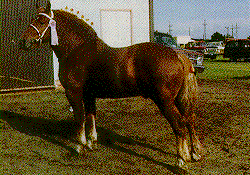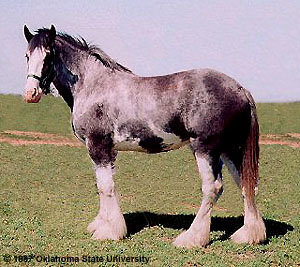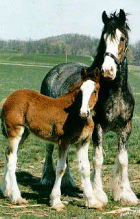| |
| |
Drafts
| |
| |
Drafts
Shire
Suffolk Punch
Clydesdale
Shire
The breed descends from England's medieval war horse, the Great Horse. The Great Horse became known as the English Black, a name bestowed by Oliver Cromwell, in the short period when England was a Commonwealth.
The principal influence in the evolution of the massive, modern Shire was the heavy Flemish or Flanders Horse. During the sixteenth and early seventeenth centuries, Dutch contractors draining the English Fenlands brought with them their strong horses. These crossed with the English stock. The Friesian is another influence which gave the English Blacks a better movement. During the reign of Charles II, the King's Household Cavalry were still mounted on the Old English Black.
The foundation stallion of the Shire breed is recognized as the Packington Blind Horse, who stood at Ashby-de-la-Zouch between 1755 and 1770. He is the first stud book published in 1878. It was not until 1884 that the name Shire came into use, when the Shire Horse Society replaced the English Cart Horse Society.
The massively built Shire weighs between 2,240 and 2,688lb. At the Wembley Exhibition in 1924 a pair of Shires pulling against a dynameter (an instrument for measuring power) exceeded the maximum reading. It was estimated that they had exerted a pull capable of moving 50 tons.
The head is of medium size, the nose is slightly convex, and the forehead is wide between the eyes. The eyes should be large and have a docile expression, indicating the kind disposition of the breed of "Gentle Giants". For a draft horse, the neck is relatively long, running back into a deep, obliquie shoulder, wide enough to carry a collar. The average girth measurement of a Shire stallion is 6-8ft and is combined with a broad, powerful chest. These are factors that denote a good, healthy constitution. The short back; thick, powerful musculature, particularly over the loins; and the wide, sweeping quarters exemplify the "strength" structure, combined with weight, that are essential in the draft horse. The limbs are clean and hard, the measurement of flat bone being 11-12in. There is heavy feather, but it should be straight and silky. The most important parts of the draft horse are the hooves and hocks. The hooves must be open, very solid and perfectly shaped with length in the pasterns. The hocks have to be broad and flat, set at the correct angle for optimum leverage and carried close together. The action is straight in front and behind. The most popular Shire color is the traditional black of the breed's forebears, with white feathering. Bay and brown are acceptable and there are numerous grays. The Shire can stand between 16.2 and 17.2hh. The average is 17hh. According to the Guiness Book of World Records, the largest horse was a 21.2 hand Shire Gelding weighing
3,360.
Suffolk Punch
The Suffolk Punch of East Anglia is the oldest of Britain's heavy horse breeds and, perhaps the most endearing. The English dictionary defines Punch as a variety of English horse, short-legged and barrel-bodied, a "short, fat fellow", and that fits its subject exactly. The unique feature of this pure breed is that every Suffolk traces its descent from one stallion. Thomas Crisp's Horse of Ufford (Orford), which was foaled in 1768. He was a "chesnut" horse, as are all Suffloks.
The Suffolk's early origins are obscure but it is inconceivable to think that the trotting Raodsters, developed in East Anglia from the sixteenth century onward, as well as the heavier Flanders mares, did not play their part in its evolution. Both possessed much the same coloring now regarded as characteristic of the Suffolk, and Flanders Horses were robust trotters.
The Suffolk Punch was developed as a farm horse. It is a clean-legged horse, without feather, and so is admirably suited to heavy clay lands. It also possesses enormous pulling power, and in the past was much in demand for heavy draft work in towns and cities. Maturing early and enjoying a long life, the Suffolk is an economical horse. Despite its unquestionable stamina and power, it thrives on less feed than is needed by other heavy breeds. On typical East Anglian farms, they are fed at 4:30am. Two hours later they go to the fields, and can work, with short rests, until 2:30 pm. Other heavy breeds would have to stop mid-morning for another feed with additional time needed to allow for digestion. A test, peculiar to the Suffolk fairs where Punches were offered for sale, was to hitch a horse to a heavy, fallen tree. The tree did not have to be moved but, to pass the test, the horse had to get right down on his knees in what is considered the typical, Suffolk, drawing attitude.
The head is quite large with a notably broad forehead and a straight or slightly convex profile, and alert and relatively short ears. The neck is deep and conforms exactly to the position of the shoulder. Mane decoration is usually for show purposes. Wonderfully deep and round-bodied, and standing on powerful, short legs, the roly poly Suffolk is among the most attractive of the heavy horse breeds. Good bone, sloping pasterns and clean legs characterize the breed. The tractive power is assisted by the low shoulder, a feature skillfully developed by early breeders. The quarters are obviously of great strength, but the hind legs must be placed sufficiently close to allow the horse to walk a 9" furrow, otherwise when going between rows of sugar beet, "he'll kick out more than he'll hoe". The hooves are of medium size, smaller than those of most heavy breeds, but hard and sound. Much attention has been given in recent years to improving the quality and conformation of the Suffolk hooves. The long tail is braided for work. Seven color shades are recognized by the Suffolk Horse Society, ranging from a pale, almost mealy color to a dark, almost brown, "chesnut". The most usual is a bright, reddish color. Suffolks stand at 16-16.3hh.
Clydesdale
The Clydesdale is a breed of no great antiquity in terms of equine history, as it has only developed over little more than the past 150 years. However, with the exception of the Percheron, it is probably the most successful of the heavy breeds in respect of its export throughout the world. It is found in Germany, the USSR, Japan and South Africa, as well as in the USA, Canada, Australia and New Zealand.
The breed has its foundation in Flemish Horses imported into the Clyde Valley, Lanarkshire, in the eighteenth century. There is also a strong Shire influence and has none of the Suffolk's rolypoly appeal, but of the three, it is the best mover, having very active paces. It is described by the Clydesdale Horse Society, which published its first stud book in 1878, as having "a flamboyant style, a flashy, spirited bearing and a high-stepping action that makes him a singularly elegant animal among draft horses".
The Clydesdale Horse Society was formed in 1877, and in the first volume of its stud book there were no less than 1,000 stallions listed. The American Clydesdale Society was founded in the following year and the breed was soon established in the USA and Canada. The head of the Clydesdale is more elegant than that of most of the heavy horse breeds. Unlike the Shire head, in which the profile is decidedly convex, the Clydesdale profile is straight, giving the impression of quality. The neck is proportionately longer than that of the Shire. The shoulder is sloped and the withers, higher than the croup in the interests of improved traction, are quite sharply defined. Cow hocks, the hind legs placed close together, are a breed characteristic. They are not judged as a conformational fault. The lower limbs carry heavy, silky feather and the hooves, although somewhat flat, are well formed and hard-wearing. Elaborately decorated tails are a feature of the heavy show horse. A best decorated horse class is held at the Royal Highland Show in Scotland. Although a big horse, the modern Clydesdale is lighter and even more active than those bred in the past. The leg often appears long, but the Clydesdale is deep through the girth. The hock joints are very strong, although cow hocks are common. The predominant colors are bay and brown but grays, blacks and roans are also found. Heavy white markings often occur on the face, legs and on the underside of the body. Average height is about 16.2hh, but stallions may be up to or over 17hh.
Reference: The Ultimate Horse Book; Elwyn Hartley Edwards; 1991
The Draft Horse Prayer
The picture of the Shire courtesy of Alberta Horse Improvement Program




The American Shire Horse Association
Clydesdale Breeders of the United States
The Draft Page
Budweiser Clydesdales
The Draft Horse Journal
Lonestar Hitch Homepage
American Suffolk Horse Association

 This Draft Horse Web Ring site is owned by
This Draft Horse Web Ring site is owned by
The White Arabian.
Want to join the Draft Horse Web Ring?
[Skip Prev]
[Prev]
[Next]
[Skip Next]
[Random]
[Next 5]
[List Sites]
The picture of the Suffolk Punch courtesy of American Suffolk Horses Assoc.
The picture of the Clydesdale courtesy of OSU Breeds of Livestock
